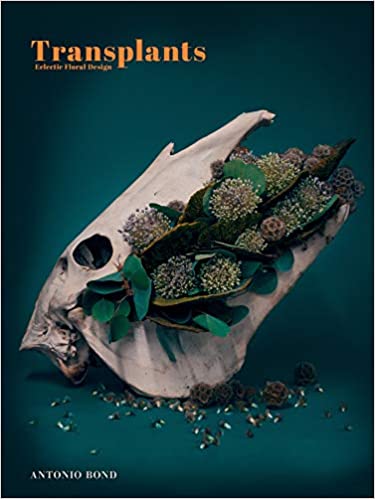
“I probably don’t fit most people’s typical image of a florist. I’m the burly guy with tattoos and a long beard in a flannel shirt,” laughs Antonio Bond. However, gaze upon any of his floral arrangements—more aptly called botanical sculptures—and it’s evident the man with the looks of a lumberjack has the vision and soul of a true artist.
A few years ago, after Bond’s work caught the eyes of the creators of Full Bloom, HBO’s floral design reality show, the Austin-based designer joined as one of 10 talented competitors on the second season. “For the first three episodes, I was really shy. I’m the person who wants my designs to speak for themselves,” he says. “But then I hit my groove, because once I’m comfortable, all bets are off and I let my guard down.” (Spoiler alert—he didn’t win but came in a very respectable third place).

A brass vessel holds a lantern-like yellow and orange arrangement of ranunculus, fennel flowers, and citrus, topped with a dark succulent.

An arrangement of tillandsias on driftwood and moss, with a pot of fuzzy, golf ball cactus makes up part of a centerpiece designed by Antonio.

Another centerpiece detail combines peonies with Buddha’s hand citron, bicolor anthuriums, and a flourish of dried bougainvillea.
When event designer Cassie LaMere enlisted Bond to create tablescapes and floral installations for a week-long glamping experience in Round Top, Texas, Bond says he was truly in his element, building his designs in the open air with a spectacular natural setting for inspiration. “I believe you get the best out of artists when you give them the freedom to do their thing. Cassie gave everyone involved in Camp Round Top just that, and it became magic,” Bond says. “It was definitely a unicorn job.” The florals seen in this article are from the Round Top event.
ANTONIO BOND’S FLORAL PHILOSOPHY
Nature guides me. It’s my biggest inspiration and I’m always looking down at my feet for what I can incorporate into my work.


Mechanics matter.I let flowers flow naturally when I can, although I use chicken wire, tape, or floral foam when there’s no other way, which can be the case when I’m not working with a traditional vase. But I never want flowers to feel stiff.

Math doesn’t factor into the equation. I don’t go in with a formula and say this arrangement is going to have five peonies or that one will have six oranges. I start at one end of the table and begin to build, and as hippie as it sounds, I let the materials talk to me and tell me what looks good together. When it works, it’s like a vibration.

A rusty roller skate is tucked into this arrangement of bittersweet berries, poke berries, red peonies, and cymbidium orchids.

A red, toy cowboy with air plant (tillandsia) in a glass sphere adds whimsy to an Antonio Bond designed centerpiece.
Tuck in a few surprises. I call them the Easter eggs of a tablescape; things like a cowboy figurine tumbling in a glass orb; dried insects nestled within the flowers; a small statue of a saint peeking out of the flowers.
Perfection is not the goal. I want the cracked and broken. I don’t mind when flowers aren’t perfect either—some might have a brown spot or a twisted stem. I appreciate that life cycle. In imperfection, there is beauty.


See more of Antonio’s work on hiswebsite, and follow Transplants Floral on Instagram.
Don’t missCassie LaMere’s elements for an unforgettable event.
See more from theCamp Round Top glamping event.





